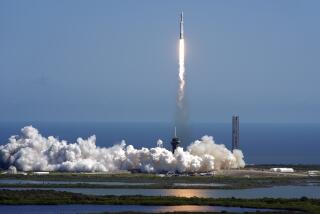Strange readings from a dead spacecraft reveal new evidence of water on Europa
- Share via
A spacecraft wouldn’t recognize evidence of a lunar geyser if that geyser hit it in the face. Luckily, the scientists on the ground did.
Researchers using 21-year-old data from NASA’s Galileo spacecraft have found evidence of a plume of material coming from the surface of Jupiter’s icy moon Europa. The discovery offers a new line of evidence for an ocean beneath its frozen crust and a promising path forward in the search for extraterrestrial life.
The results show that old data from long-gone spacecraft “hold a lot of secrets we haven’t yet uncovered,” said Lori Glaze, acting director of NASA’s Planetary Science Division.
If humans are to look for life on other worlds, one of the first places scientists say they want to probe is cold, distant Europa. One of the four large moons circling our solar system’s biggest planet, Europa’s frigid shell is thought to hide a global ocean that may hold twice as much water as Earth.
That ocean is kept “warm” (relative to local standards) and liquid thanks to energy from enormous tidal forces, as the moon is squeezed and stretched largely by Jupiter’s gravitational pull. With enough heat and life-friendly chemicals, such an ocean could potentially host the kinds of microbes that are found in the depths of Earth’s oceans.
Saturn’s much smaller moon Enceladus is also thought to have a sizable, potentially habitable ocean — an idea bolstered by the plumes of water vapor and ice that NASA’s Cassini spacecraft spotted shooting out from the surface in 2005.
Europa seemed quiet by comparison until 2012, when NASA’s Hubble Space Telescope spotted chemical hints of water molecules near the southern pole. If confirmed, these icy geysers would provide a sample of the subsurface ocean. But researchers debated whether the data truly revealed the presence of such plumes.
A breakthrough came thanks to a presentation that Melissa McGrath of the SETI Institute gave about the locations of potential plumes from Hubble images.
As he listened to her talk, lead author Xianzhe Jia, a space physicist at the University of Michigan in Ann Arbor, came to a realization: One of those possible plume spots lay near a region visited by NASA’s Galileo spacecraft, which explored the Jovian system from 1995 to 2003. Perhaps additional evidence of a plume was hidden in the dead satellite’s decades-old data.
“That is the moment that really, I think, led us to realize that we had to go back to look at Galileo data,” Jia said.
The researchers looked at Galileo data from a December 1997 flyby, when the spacecraft swooped to just 124 miles above Europa’s surface.
Having already studied Enceladus, scientists knew that these kinds of plumes in space could affect the magnetic field and plasma environment, Jia said. So he ran simulations taking into account the apparent plume dimensions from Hubble as well as the magnetometer and plasma wave data from Galileo.
The team found that as the spacecraft made its close approach to Europa’s surface, the magnetic field went wild and the plasma density shot up — an indication that the spacecraft was actually passing through a plume.
“These results provide strong independent evidence of the presence of plumes at Europa,” the study authors wrote.
This discovery could inform plans for NASA’s Europa Clipper mission once it reaches the Jovian satellite, said Elizabeth Turtle, a research scientist at the Johns Hopkins University Applied Physics Laboratory in Laurel, Md., who was not involved in the study.
Turtle leads the imaging system for Clipper, planned for launch as early as 2022. The spacecraft’s instruments are tailored to sample the ice and dust particles coming from such plumes in order to determine whether the moon really could be friendly to microbial life.
Though the new plume findings in all likelihood won’t affect the instrument design, they might influence the path the spacecraft takes and the plumes it targets, the researchers said.
“The habitability of Europa is one of the big questions that we want to understand,” Turtle said.
Follow @aminawrite on Twitter for more science news and “like” Los Angeles Times Science & Health on Facebook.
MORE IN SCIENCE
How hard is it to fly a helicopter on Mars? NASA will soon find out
Scientists develop a 3-D view of an interstellar cloud, where stars are born
As more older Americans struggle with dementia, what happens to their guns?







